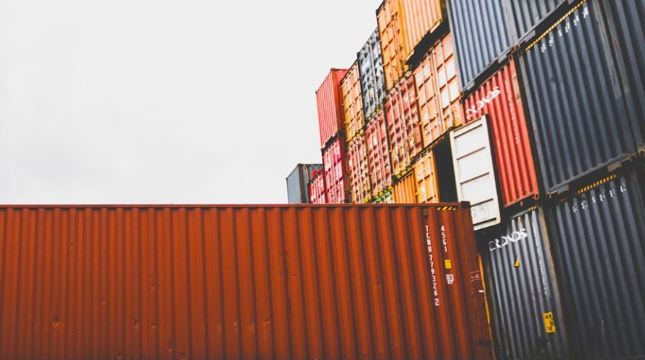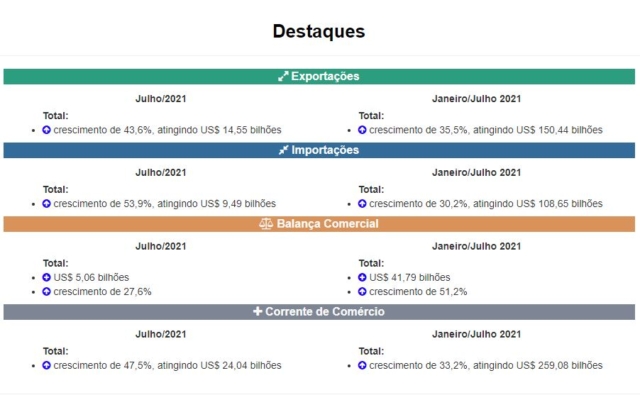
Trade balance registers a US$ 41.79 bi surplus in the year after the third week of July
Jul, 19, 2021 Posted by Ruth HollardWeek 202129
The Brazilian trade balance registered a surplus of US$ 41.79 billion in the accumulated result for the year up to the third week of July, growing 51.2% compared to the surplus from January to July 2020. The trade flow (exports + imports) increased 33.2% in the period, reaching US$ 259.08 billion. Exports up to the third week of July grew 35.5% and totaled US$ 150.44 billion, while imports rose 30.2% and totaled US$ 108.65 billion, according to data released this Monday (19/7 ) by the Foreign Trade Secretariat (SECEX) of the Ministry of Economy.
Compared to July 2020, exports grew 43.6% in the month, totaling US$14.55 billion. Imports increased 53.9% and totaled US$ 9.49 billion. Thus, the trade balance registered a surplus of US$ 5.06 billion, an increase of 27.6%, and the trade flow rose 47.5%, reaching US$ 24.04 billion.
Exports of the month
SECEX verified an increase in exports in July in all sectors. There was a 20.7% growth in agriculture, at US$ 2.98 billion; an increase of 69.7% in the extractive industry, which reached US$ 4.16 billion; and a 42.2% increase in sales in the manufacturing industry, which totaled US$ 7.36 billion.
On the agricultural side, growth was driven by sales of soy (+40%), raw wood (+326.6%), and fresh or refrigerated vegetables (+44.5%). In the mining and quarrying industry, the highlights were increases in exports of iron ore and concentrate (+109.7%), crude petroleum or bituminous crude mineral oils (+36.6%), and stone, sand, and gravel ( +83.6%).
The transformation industry sold more fuel oils from petroleum or bituminous minerals, except for crude oils (+139.7%), semi-finished products, ingots and other primary forms of iron or steel (+232.6%), and soybean meal and other animal foods (excluding unground cereals), meat, and other animal meal (+58.7%).
Monthly Imports
Brazil also bought more in all sectors this month, up to the third week. The growth was 33.5% in agricultural imports, which totaled US$ 224.54 million; 121.8% in the extractive industry, at US$ 534.10 million; and 52% in the manufacturing industry, which reached US$ 8.63 billion.
In agriculture, the growth in imports was influenced by the increase in purchases of whole live, processed, or refrigerated fish (+113.5%), latex, natural rubber, balata, gutta-percha, guayule, chicle, and natural gums (+153, 4%), and unground wheat and rye (+16.4%).
Among the products of the extractive industry, the highlights were purchases of liquefied or not liquified natural gas (+354.1%), crude petroleum or crude bituminous mineral oils (+44.3%), and coal, even in powder form, but not agglomerated (+111.9%).
In the manufacturing industry, the biggest increases were in purchases of fertilizers or chemical fertilizers, except for raw fertilizers (+51.9%), parts and accessories for automotive vehicles (+145.7%), and fuel oils from petroleum or bituminous minerals, except crude oils (+68.1%).
-
Automotive
Oct, 08, 2024
0
Brazil’s Vehicle Exports Surge in Q3 Despite Year-to-Date Decline
-
Other Logistics
Jun, 14, 2024
0
Kuehne+Nagel announces new fleet of electric vehicles for last mile operations in Brazil
-
Fish
Oct, 11, 2022
0
Brazilian purchases of salmon from Chile back to pre-pandemic levels
-
Ports and Terminals
May, 05, 2022
0
Pernambuco is now closer to reclaiming the autonomy of the Port of Suape


